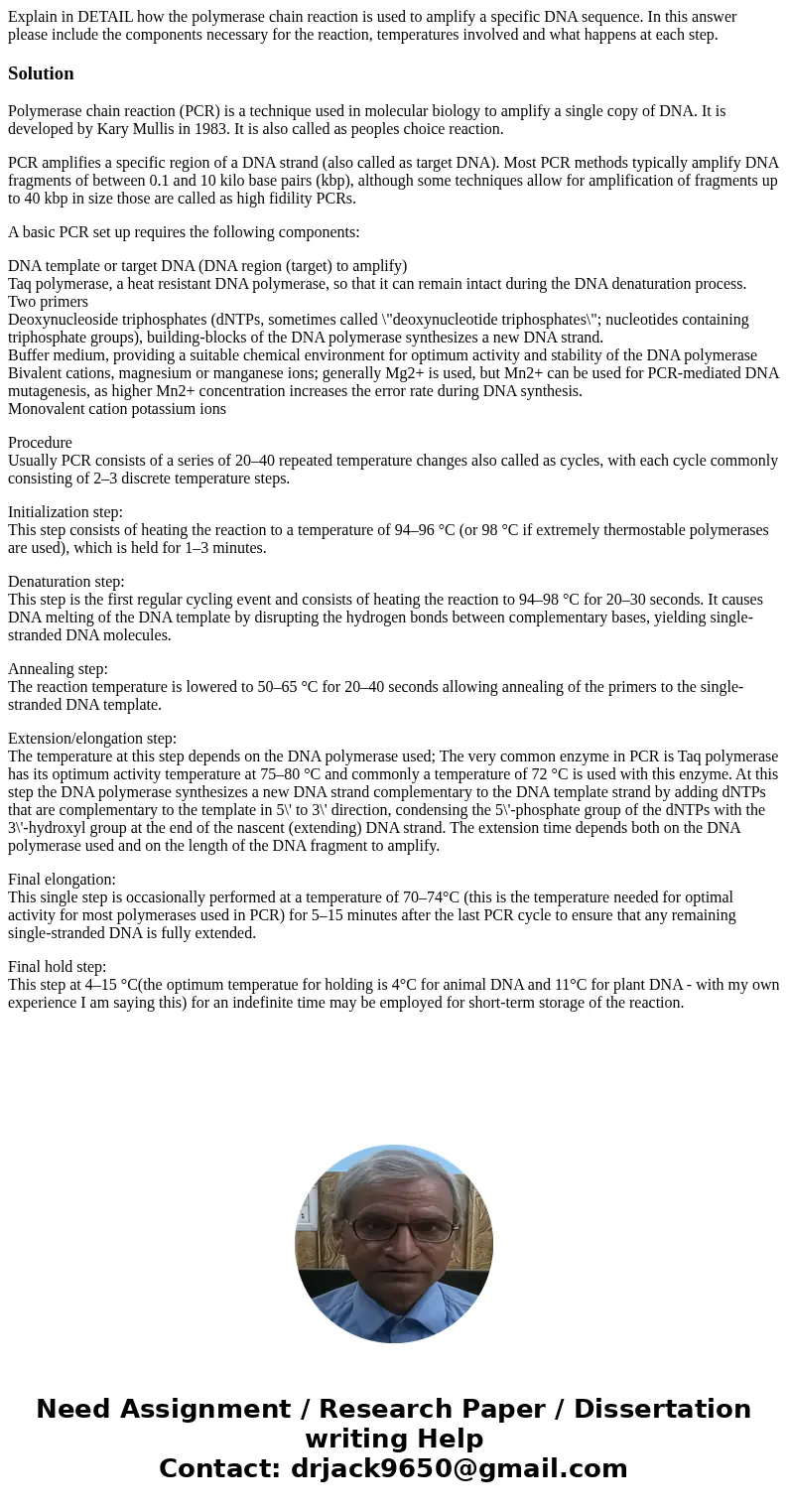Explain in DETAIL how the polymerase chain reaction is used
Solution
Polymerase chain reaction (PCR) is a technique used in molecular biology to amplify a single copy of DNA. It is developed by Kary Mullis in 1983. It is also called as peoples choice reaction.
PCR amplifies a specific region of a DNA strand (also called as target DNA). Most PCR methods typically amplify DNA fragments of between 0.1 and 10 kilo base pairs (kbp), although some techniques allow for amplification of fragments up to 40 kbp in size those are called as high fidility PCRs.
A basic PCR set up requires the following components:
DNA template or target DNA (DNA region (target) to amplify)
Taq polymerase, a heat resistant DNA polymerase, so that it can remain intact during the DNA denaturation process.
Two primers
Deoxynucleoside triphosphates (dNTPs, sometimes called \"deoxynucleotide triphosphates\"; nucleotides containing triphosphate groups), building-blocks of the DNA polymerase synthesizes a new DNA strand.
Buffer medium, providing a suitable chemical environment for optimum activity and stability of the DNA polymerase
Bivalent cations, magnesium or manganese ions; generally Mg2+ is used, but Mn2+ can be used for PCR-mediated DNA mutagenesis, as higher Mn2+ concentration increases the error rate during DNA synthesis.
Monovalent cation potassium ions
Procedure
Usually PCR consists of a series of 20–40 repeated temperature changes also called as cycles, with each cycle commonly consisting of 2–3 discrete temperature steps.
Initialization step:
This step consists of heating the reaction to a temperature of 94–96 °C (or 98 °C if extremely thermostable polymerases are used), which is held for 1–3 minutes.
Denaturation step:
This step is the first regular cycling event and consists of heating the reaction to 94–98 °C for 20–30 seconds. It causes DNA melting of the DNA template by disrupting the hydrogen bonds between complementary bases, yielding single-stranded DNA molecules.
Annealing step:
The reaction temperature is lowered to 50–65 °C for 20–40 seconds allowing annealing of the primers to the single-stranded DNA template.
Extension/elongation step:
The temperature at this step depends on the DNA polymerase used; The very common enzyme in PCR is Taq polymerase has its optimum activity temperature at 75–80 °C and commonly a temperature of 72 °C is used with this enzyme. At this step the DNA polymerase synthesizes a new DNA strand complementary to the DNA template strand by adding dNTPs that are complementary to the template in 5\' to 3\' direction, condensing the 5\'-phosphate group of the dNTPs with the 3\'-hydroxyl group at the end of the nascent (extending) DNA strand. The extension time depends both on the DNA polymerase used and on the length of the DNA fragment to amplify.
Final elongation:
This single step is occasionally performed at a temperature of 70–74°C (this is the temperature needed for optimal activity for most polymerases used in PCR) for 5–15 minutes after the last PCR cycle to ensure that any remaining single-stranded DNA is fully extended.
Final hold step:
This step at 4–15 °C(the optimum temperatue for holding is 4°C for animal DNA and 11°C for plant DNA - with my own experience I am saying this) for an indefinite time may be employed for short-term storage of the reaction.

 Homework Sourse
Homework Sourse